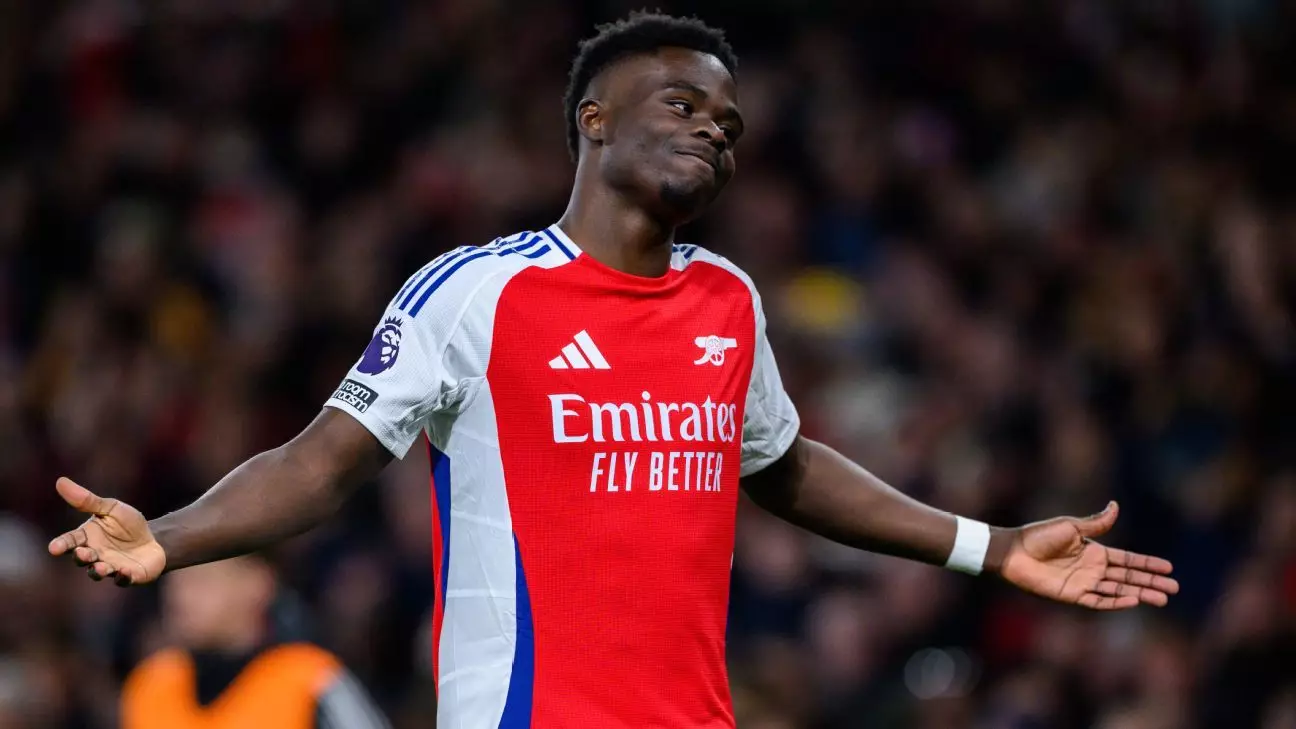In the world of football, talent often comes with a heavy burden. For Bukayo Saka, the resurgence of Arsenal Football Club has pivoted largely upon his shoulders. The recent match against Fulham, a narrow 2-1 victory, highlighted not just Saka’s individual brilliance but also the team’s desperate need for rejuvenation. After a significant 100-day period of recovery following a hamstring surgery, Saka made a speedy impact upon his reintroduction to the team, scoring within just seven minutes of his arrival on the field. It’s clear that the hope for a resurgence of Arsenal’s season heavily rests on Saka, and while his presence brings renewed enthusiasm, it also raises compelling questions about the depth and resilience of the squad in his absence.
Brush with Mediocrity
Prior to Saka’s return, the Gunners struggled noticeably, especially against a depleted Fulham side that had recently faced their own struggles following an FA Cup defeat. It is telling of Arsenal’s current state that they managed only a deflected goal through Mikel Merino in the first half, as the Emirates Stadium felt the weight of an ongoing slump. Enthusiasts and analysts alike are beginning to look beyond mere statistics; the team had lost its attacking vibrancy, thus leaving fans oscillating between hope for catching Liverpool in the league and trepidation as they prepare for a UEFA Champions League quarterfinal tie against Real Madrid.
In many ways, Arsenal’s lackluster performance served as a stark reminder of their ongoing quest for stability. The balance between longing for immediate glory and addressing longstanding deficiencies has created a complicated dynamic within the club. Enter Saka—his return wasn’t just a personal milestone but a symbol of potential rejuvenation for the team.
A Shared Celebration of Resilience
Arsenal’s scene during Saka’s re-integration sparked a wave of energy, underscoring the psychological importance of such triumphs in sports. Manager Mikel Arteta remarked on the palpable shift in stadium energy, demonstrating the role of morale in team dynamics. The connection between players goes beyond mere professionalism; it is built on shared struggles and triumphs. The joyous celebration of Saka’s goal with Sam Wilson, the team’s physical performance coach, serves as a reminder of the collective effort behind the scenes, often going unnoticed in the broader discourse.
But while Saka’s return certainly reignited the spirits of the fans and players alike, it casts a significant shadow on the fragility of the squad. His career has already crossed multiple milestone markers at just 23 years old, achieving double figures in both goals and assists in the past three seasons—a feat last accomplished by the illustrious Alexis Sánchez. Yet, with reinforcements like Saka coming back, the narrative must also include a discussion of Arsenal’s vulnerabilities—especially in defense.
The Fragility of Team Composition
Saka’s timely intervention raises the stakes, but the uncertainty surrounding the health of key defenders like Gabriel Magalhães presents a critical dilemma. When he left the match injured, it sent shockwaves through the squad. His partnership with William Saliba establishes the backbone of Arsenal’s ambitious defensive strategy. The sight of Gabriel limping off fueled concerns about the potential ramifications, especially as they gear up for a clash with football heavyweights like Real Madrid.
The moment in the latter part of the match, where Jakub Kiwior struggled to keep pace with Adama Traoré, highlighted the unsettling reality facing Arsenal—a defense that holds the potential for vulnerability at the worst possible moments. The risk of injuries disrupting team cohesion has become an all-too-frequent narrative this season, forcing Arteta into a defensive rewriting of strategy almost week to week.
Embracing Challenges for Growth
Arteta’s approach to managing a team beset by injuries juxtaposes introspection with motivation. Each setback has provided opportunities for growth, both individually and collectively, as the head coach implores his players to adapt rather than succumb to despair. While the adversity may be daunting, it is precisely in moments like these that character is forged. Saka’s energy is essential for instilling a sense of urgency that the team desperately needs, particularly against formidable opponents that lurk ahead on their schedule.
And yet, while Saka’s resurgence is promising, the weight he bears is not exclusively his own. If Arsenal hopes to end this season on a high, the entire squad must elevate their contributions and address their vulnerabilities. As they navigate the complexities of injuries and competition, a collective effort will be crucial. The Gunners’ journey ahead remains fragile yet filled with potential as they look to strike a chord with success in the rounds that lay ahead.


Leave a Reply